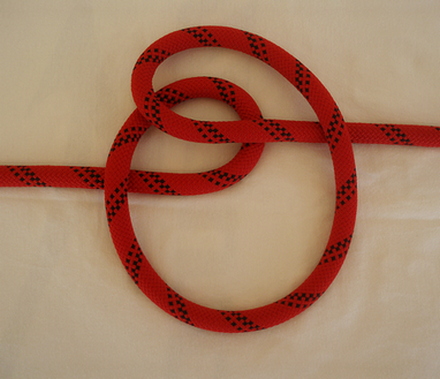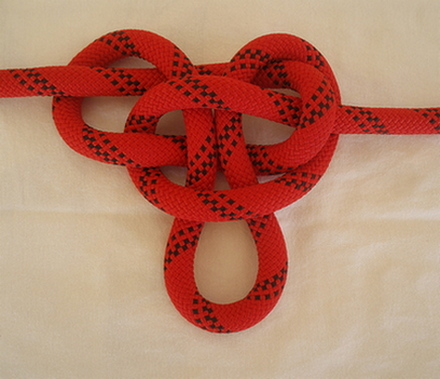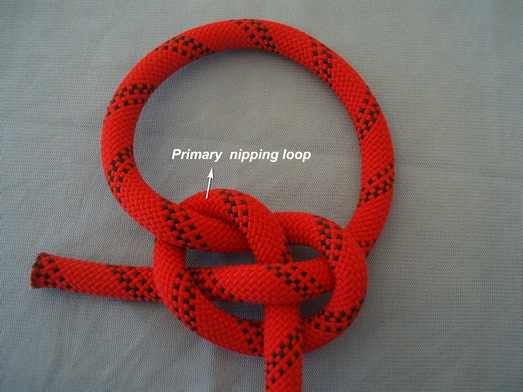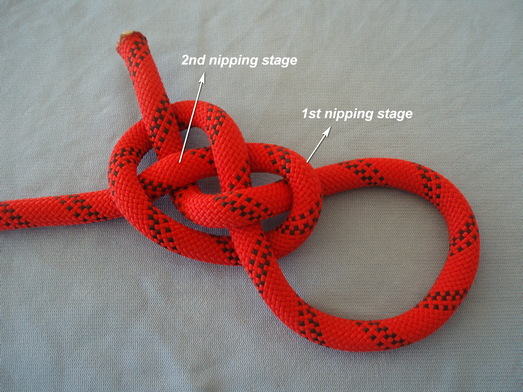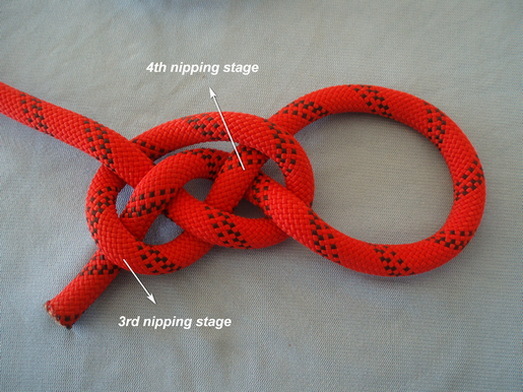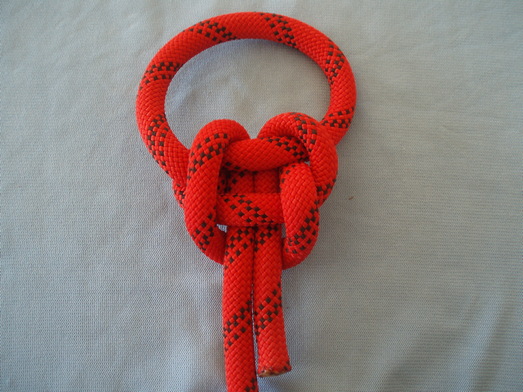Re tying methods for this knot, my hybrid style “loop on the hand w/X-crossing underneath” will get you one tied, dressed and set in 7 secs. Just make the “X” in the opposite direction with the other hanging strand and proceed from there with the appropriate over/under maneuvers. https://youtu.be/DYGdvL9-P30
Good day Alpineer
I see that you have attuned your hybrid tying method to form a false butterfly as well. Thanks for bringing this in, the only con i would add, is that is not so straight forward as tying the butterfly, because you have to brake the two loops apart and place one upon the other, continuing with the over, under maneuvers. However, it is more memorable, in the sense that one does not need to remember the chirality of the two small loops, i’ll give you that.
Your hybrid method of tying the alpine butterfly is more suitable for me, as i find that you can easily adjust the size of the eye. It resembles with one of my own, but only in the final stage, where you are adjusting the size of the bight you are going to feed through the two loops. This very method, relies on a type of pretzel structure formation, but i think yours is quicker and easy to remember.
I’m not sure how to interpret what you’re saying re “bowlinesque descent”. However, performing D.L.'s backflip/halter maneuver on the FBK produces two healthy B’lines; depending on the direction, either twinned or splayed.
Good call Alpineer. I have just tied them and in this initial phase they look healthy to me too. I guess, i prefer the splayed version, but i am not sure about the EEL ability, as i have the sense that i have to load it from the weak link of the FBK for a stable structure development. I wonder, if they have been tied before. If not, they’re waiting for your moniker ;).
All i am saying is that the parent knot, is a TIB 1010 bowline. Check out how Alan Lee ties the Jug sling knot, starting from the tib 1010 variant. Link : [i]https://www.youtube.com/watch?v=WBDn25h80KU[/i].
All you have to do to reveal EHL, is to flip the collar that encircles both eye legs, plus the nipping loop of the bowline. That said, even so i am refering to an end of line profile of the knot with this paradigm, the same stands for the midline structure, therefore i am tracing EHL’s origin by laying emphasis on this equivalence, not only in a topological but in a functional sense too.
In other words, i have produced a retucked version of a bowline, or a second order bowlinesque type of knot, or a squared bowline, that inherits all its good properties like jam resistance, being simultaneously far more secure and stable than the parent.
I think we’ve made our points, time to move on.
Hello tsik_lestat,
I would like your permission to include your bi-axially loadable TIB eye knot (‘EHL’) in my paper on the Butterfly knot.
If you grant permission - I will need some historical info…eg discovery date, the inspiration that led you to its discovery and your real name, etc.
Also need any test data - ie any load tests that have been conducted in human rated EN ropes (eg EN1891 or Sterling HTP).
Of importance to me would be test data on bi-axial through loading (SPart-to-SPart) and also various types of eye loading.
Jam resistance data is of high importance to me…
You can PM me to let me know…
Mechanical functionality appears to be good. However, any advantage that it might conceivably have over the ABK re jamming immunity comes at the price of extra complexity. It would have to solve a problem that climbers experience on a regular basis in order to be considered. In situations where the ABK is typically used, I wouldn’t think the forces enough to cause a jamming incident. Perhaps rescue loads on low stretch rope could initiate jamming. Agent Smith?
A curiousity of doubled back nipping structures is that they can cause the knot to have more than one possible dressing geometry, which may be of concern.
This fellow managed to jam an ABK in an ill suited towing application.
https://igkt.net/sm/index.php?topic=6150.0
@ agent_smith
Undoubtedly, it goes without saying,that you have absolute permission, to deal with this knot, in whatever way you desire, and i personally thank you for your intention to include it in your ABK’s upcoming paper. I shall contact you to provide with every additional info i know. Mind you, there’s not so much, as official test data conducted in human EN rated ropes, are rather scanty at the moment.
Some further contributions might be added, regarding the tying method of the midline mirrors, as well as a variation of an end termination profile, which adds even more security.
For those interested, the span loop midline structure, appears to accomodate the same tucking as EHL does, generating a bulkier profile, due to its more complex link.
However, any advantage that it might conceivably have over the ABK re jamming immunity comes at the price of extra complexity.
That’s true, stability and jam resistance comes at the price of some bulkyness, along with some difficulty to form on stiff ropes, but nonetheless, i believe it operates on the margin of admissible and balanced complexity. I am of the view, that sometimes you got to go a bit more complex to achieve the desired functionality, but not going too far.
I’d also comment, that the flexibility of loading EHL’s eye without observable jamming incidents, adds some extra versatility, in contrast with ABK’s eye loading profiles that are likely more prone to jamming, as fellow climbers and testers report.
A curiousity of doubled back nipping structures is that they can cause the knot to have more than one possible dressing geometry, which may be of concern.
This particular dressing state, appears to be immensely stable, where the eye bight is firmly clamped, enjoying full constriction from both EHL’s links, that can hardly deform under high strain.
Thanks for your evaluation, it’s much appreciated.
l wonder if they've been tied before.
Centuries ago, no doubt.
That might be the case, but until proven otherwise, a moniker like Double Alpineer’s FBK loops, sounds eligible and rather euphonic so far ( aka Double Lineman’s ABK loops :)).
Requesting load testing to determine jamming resistance in the following loading profiles:
Bi-axial loading from SPart-to-SPart
Eye loading (with one SPart anchored)
Alan Lee perhaps?
Or anyone else?
[u]Mirror tying method[/u]
-
Form a Z loop, a bight, and an S loop knotting scheme, like the one illustrated in first image (in contsast with the tying method described at reply#1, where the initial configuration was S loop, bight, Z loop).
-
Place the S loop over the Z loop, (or the Z over the S loop), as shown in second image. Note, that you have to place the S loop, (or the Z loop), on Z loop’s segment that is a direct continuation of the bight component, in contrast with the tying method presented at reply#1.
-
Pass the bight through this configuration, in the following order, ~ under, over, under, over ~.
The resulting mirror knot is shown in the next two images, in a loose dressing state, in front and back view.
Can I assume that the TIB and bi-axially through loadable (BTL) eye knots presented at reply #31 and #32 are a claim of originality by tsik_lestat?
I need confirmation from the creator - because I really like these knots and want to include them in my upcoming paper on the #1053 Butterfly knot.
I also need to know if any load testing has been done to investigate jamming threshold in a variety of different loading profiles such as:
bi-axial through loading (from SPart-to-SPart so that the eye is isolated from load)
axial eye loading (in both directions aligned with each respective SPart)
transverse loading of the eye (some may prefer to use the term ‘ring loading’)
Has Alan Lee done any load testing?
New evidence has emerged, which suprisingly prove that the EHL midline eyeknot, is a pre-existing knot structure, and apparently, a very old one too.
I have recently been informed by a brilliant collaborator and a valuable contributor, Knotsaver (Saverio), who has a thorough knowledge about knotting, that there had been a short reference of the knot presented in this thread, in the book “Encyclopedia of knots and fancy ropework” by Raul Graumont and John Hensel, first published in 1939, which appears in chapter II, titled “Simple knotting” on page 58, under the moniker of Cask knot.
I have attached photos of all the related content, thanks to Saverio, who was kind enough to enlighten me and deliver all the related material from his own book copy.
In this short reference, the authors provide an “in the end method” of tying the inline profile (??), and they also claim that there is no practical value, without providing any supporting arguments.
Having delved deeper into the mechanics and the topology of this particular knot structure, i’ll have to add that i respectfully disagree with the viewpoint of the authors.
Also, many thanks to master Xarax, who has managed to ferret out another, a bit more recent, appearence of the knot, on a knotting board from the Mariner’s museum and Park in Houston Texas, which dates from 1954.
It is number 64, the photo at the end of the page is great, you can zoom in to see all the details of this magnificent artwork.
Link : The Mariners' Museum Online Catalog
Anyone, who may know or may sniff out any additional info about the so called “Cask knot”, is encouraged to appose it in this topic for further evaluation!
Afterall, we are still on the lookout for the original creator! ![]()
tsik_lestat
In the same Plate 21, page 57. the configuration of the Jug Sling (Fig.1-A B) is the same as Cask Knot (Fig.8-A B). Also see my previous reply #12 and 18.
Happy Knotting
yChan
Siriuso, thank you for your apt observation, you may consider it as my omission, even though i was aware for their illustration in the same plate, of the book cited previously.
Although the topological equivalence between the two knots (cask/jug sling) is obvious, but not pointed out by the authors (their omission :D), it seems to me that a couple of component rearrangements, render two geometrically and functionally separate configurations.
Note also the resemblance, between your depicted tying method, (taken from the book), and the one described in detail, at reply#32.
Yet still, we didn’t get any closer to the mysterious Cask knot inventor, did we? ![]()
This reminds me that any claims of originality - in the fullness of time - can be hard to sustain and may result in disappointment.
Oh well.
What occurs all too often is independent rediscovery.
I’m surprised Dan Lehman hasn’t chimed in with comments about the Hensel and Graumont publication… where the accuracy and reliability of the published content is often called into question.
I agree with tsik_lestat that the authors comments re “has no practical value” - is itself of no value!
I think some testing needs to be undertaken to determine jam resistance in various loading profiles.
The #1053 Butterfly knot jams when heavily eye loaded (when the eye is loaded axially in alignment with an SPart).
However, #1053 Butterfly is jam resistant when bi-axially through loaded (from SPart-to-SPart).
I have loaded this knot only to 2.0-3.0kN and found:
eye loaded (with the eye loaded in axial alignment with an SPart) = a lot of distortion but did not jam at these loads
bi-axially through loaded from Spart-to-SPart = a lot of compression of the core but did not induce jamming.
(using human rated EN1891 or EN892 rope)
Obviously, these loads are trivial and more work needs to be done.
A detailed analysis of the Cask, second order, bowline
Starting from a Z nipping loop this time, as the most favoured nipping form, i have tied a conventional 1010 bowline, and have straightened the bight structure, or in other words, i have formed a marlinspike, or a snap bowline.
Considering that, if i load the first image structure, i bring back the 1010 bowline, how do i get to retain this three stage (two from the SPart and one from the out-going leg), marlin spike nippin form?
One way is to capture SP and then follow the returning structure routing, with a marlinspike bowline, but this is not what i’m looking for in this case.
In the second (cask) method, the direct SPart continuation, is designated as the primary nipping loop (of the nipping structure), which clamps both collar legs (bowline rule), as shown in second image.
The last maneuver, is to feed the WE back through the collar, parallel to SP (third , fourth image).
This is the heart of the knot, where the tug end is being subjected to a forceful, three (or four) strand, constriction effect, which firmly secures it.
I count eight contact/constriction points in total , with this interweaving, three in the snap stage, and five in the Cask stage, which leads me to believe that this is a super inherently secure, jam proof, bowline.
PS1 : The knots are illustrated from a detailed angle/view of a bowline (except last image).
PS2 : The 7th constriction point (the collar),as the less nipping component, is not actually part of the nipping structure, however, if i was to enhance it with more nipping action, i would had tied the knot in reverse, which is also a very secure , decent, profile.
The Dines and the reverse Cask knot
The idea is to reverse the previous structure, by forming at first the Cask scheme, as a nipping component, then interweave it with a crossing knot.
The first phase of this process is to create the Dines knot. If someone examines the Dines from both sides, he/she will notice the four nipping stages (two from the SPart and two from the outgoing eye leg) of the tug end, as shown in the first two images.
Considering that, Xarax and Alan Lee showed that when this adjustable mechanism is loaded, it locks/capsizes in two fixed forms, the Chinese loop and the Samisen bowline, the same question stands in this case too:
How do i get to maintain this remarkable, symmetrical nipping form, with the less possible distortion?
The answer is to complete the second part of the reverse Cask knot by capturing the returning eye leg and then follow Sp’s routing.
While this final maneuver stabilises the Dines nipping form, making the most of all its solid nipping power, it also subjects the tug end to a second constriction wave by the nipping structure (6 salient constriction points in total), this time with more nipping action by the collar (third ,fourth image).
I find no need this time to cross the ends for more nipping power, because there is more than enough, in order to qualify as a super inherently secure configuration (without the use of overhands or eights) :D!
Yes, it will cinch a lot more in relation to the previous structure, but hopefully, not to a point of initiating jamming.

